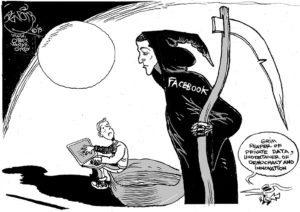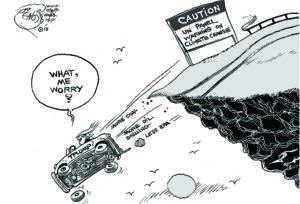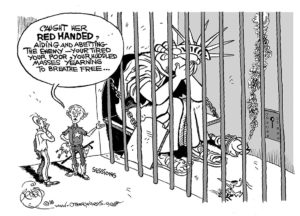Every year, Project Censored scours the landscape for the most important stories that the mainstream corporate media somehow missed, and every year the task seems to become a bit stranger. Or “curiouser and curiouser” as suggested in the subtitle of this year’s volume of the organization’s work, Censored 2020: Through the Looking Glass, which includes its full list of the Top 25 censored stories and much, much more about the never-ending struggle to bring vitally important hidden truths to light.
In the forward, “Down the Rabbit Hole of ‘Media Literacy’ by Decree,” Sharyl Attkisson, an Emmy Award-winning investigative journalist, highlights the absurdity of “so many well-organized, well-funded efforts to root out so-called ‘fake news,’ which — as we’ll see below — have significantly impacted the kinds of journalists and outlets who have historically produced the stories that make Project Censored’s list in the first place.
“The self-appointed curators, often wielding proprietary algorithms, summarily dispense with facts and ideas that they determine to be false — or maybe just dangerous to their agendas,” Attkisson notes. “Thanks to them, we will hardly have to do any of our own thinking. They’ll take care of it for us.”
Does that seem hyperbolic? Well, read on, dear reader, read on. In Project Censored’s No. 2 censored story this year, you’ll discover Facebook partnering with a NATO-sponsored think tank to “monitor for misinformation and foreign interference” — a think-tank whose funders include the U.S. military, the United Arab Emirates, weapons contractors, and oil companies and whose board includes Henry Kissinger, the world’s most famous war criminal. Who better to tell you who to believe? Or better yet, decide who you’ll never even hear from?
Through the looking glass, yes, indeed.
In the beginning, Project Censored founder Carl Jensen was partly motivated by the way early reporting on the Watergate Scandal never crossed over from being a crime story to a political story until after the 1972 election coverage. It wasn’t censorship in the classic sense practiced by church and state since time immemorial, but it was an example of something even more insidious because no clear-cut act of censorship or all-powerful censor was needed to produce the same result of a public left in the dark. Jensen defined censorship as “the suppression of information, whether purposeful or not, by any method — including bias, omission, underreporting, or self-censorship — that prevents the public from fully knowing what is happening in its society.” And the most obvious way to start fighting it was to highlight the suppressed information in the form of the stories that were not widely told. Thus, Project Censored and its annual list of censored stories were born.
Jensen’s conception of censorship may be light-years away from how most media figures think of things, but while introducing this year’s list of stories, the volume’s co-editor, Andy Lee Roth, quotes media legend Walter Lippmann echoing the same sensitivity in his 1920 book, Liberty and the News: “Whether one aspect of the news or another appears in the center or at the periphery makes all the difference in the world.”
But Project Censored was never just about the individual stories. It was about the patterns of marginalization and suppression that could be seen through the lens of connection. In his introduction, Roth says, “Identifying these unifying themes is one significant way to gauge the systemic blind spots, third rails, and ‘no-go’ zones in corporate news coverage.” He identifies several such patterns, which are stronger and more vivid in the full list of Project Censored’s Top 25 stories but still illuminating in terms of the Top 10. Stories 1 and 2 deal with press freedoms, stories 2, 4, and 9 deal with corporate misconduct, stories 2 and 10 deal with technology, stories 3 and 4 deal with the environment, stories 5, 6, and 8 deal with gender inequalities, and stories 6, 7, and 8 deal with criminal justice, prisons, and detention.
As you can see, these patterns overlap. Stories 2, 4, 6, and 8 are all part of at least two. And there may well be other patterns you discover for yourself. These patterns don’t just connect issues and problems that those in power would rather neglect. They also connect people, communities, and potential solutions that those in power would rather stay disconnected. So don’t just read the following as a list of stories “out there.” Read it as an opportunity to connect:
1. Justice Department’s Secret FISA Rules for Targeting Journalists
The federal government can secretly monitor American journalists under the Foreign Intelligence Surveillance Act, or FISA, which allows invasive spying and operates outside the traditional court system, according to two 2015 memos from then-Attorney General Eric Holder. The memos were obtained by The Knight First Amendment Institute at Columbia University and the Freedom of the Press Foundation through an ongoing Freedom of Information Act lawsuit, which was reported on by The Intercept, whose parent company provides funding for both organizations. But the story was virtually ignored by the corporate media.
The secret rules “apply to media entities or journalists who are thought to be agents of a foreign government or, in some cases, are of interest under the broader standard that they possess foreign intelligence information,” The Intercept reported.
Project Censored cited three “concerning” questions that the memos raise.
First, how many times have FISA court orders been used to target journalists, and are any currently under investigation? Second, why did the Justice Department keep these rules secret when it updated its “media guidelines” in 2015? And third, is the Justice Department using FISA court orders — along with the FBI’s similar rules for targeting journalists with National Security Letters (NSLs) — to “get around the stricter ‘media guidelines’”? The corporate media virtually ignored these revelations when they occurred. The subsequent media interest in FISA warrants targeting Trump campaign adviser Carter Page “has done nothing at all to raise awareness of the threats posed by FISA warrants that target journalists and news organizations,” Project Censored observed.
Project Censored ended with a quote from Krishnan, summarizing the stakes: “National security surveillance authorities confer extraordinary powers. The government’s failure to share more information about them damages journalists’ ability to protect their sources and jeopardizes the news gathering process.”
2. Think Tank Partnerships Establish Facebook as a Tool of U.S. Foreign Policy
 In the name of fighting “fake news” to protect American democracy from “foreign influences,” Facebook formed a set of partnerships with three expert foreign influencers in 2018, augmenting its bias toward censorship of left/progressive voices.
In the name of fighting “fake news” to protect American democracy from “foreign influences,” Facebook formed a set of partnerships with three expert foreign influencers in 2018, augmenting its bias toward censorship of left/progressive voices.
In May 2018, Facebook announced its partnership with the Atlantic Council, a NATO-sponsored Washington, D.C., think tank to “monitor for misinformation and foreign interference.”
The council is funded by the U.S. Department of State and the U.S. Navy, Army, and Air Force, along with NATO, and various foreign powers and major Western corporations, including weapons contractors and oil companies, including Chevron, ExxonMobil, and Royal Dutch Shell, noted Adam Johnson, writing for the media watch group FAIR.
The major news outlets covering the story said nothing about any of the above conflicts of interest.
In September, Facebook announced it would also partner with two Cold War-era U.S. government-funded propaganda organizations: the National Democratic Institute and the International Republican Institute.
In October 2018, Jonathan Sigrist, writing for Global Research, described one of the greatest Facebook account and page purges in its troubled history: “559 pages and 251 personal accounts were instantly removed from the platform. … This is but one of similar, yet smaller, purges that have been unfolding in front of our eyes over the last year, all in the name of fighting ‘fake news’ and so-called ‘Russian propaganda.’ ”
3. Indigenous Groups from Amazon Propose Creation of Largest Protected Area on Earth
When news of unprecedented wildfires in the Amazon grabbed headlines in late August, most Americans were ill-prepared to understand the story, in part, because of systemic exclusion of indigenous voices and viewpoints, highlighted in Project Censored’s No. 3 story — the proposed creation of an Amazonian protected zone the size of Mexico, presented to the United Nations Conference on Biodiversity in November.
The proposal, which Jonathan Watts writing for The Guardian described as “a 200 million-hectare sanctuary for people, wildlife, and climate stability that would stretch across borders from the Andes to the Atlantic.” The proposal was advanced by an alliance of some 500 indigenous groups from nine countries known as the Coordinator of the Indigenous Organizations of the Amazon Basin, which called it a “sacred” corridor of life and culture.
“We have come from the forest, and we worry about what is happening,” declared Tuntiak Katan, vice president of COICA, as quoted in The Guardian. “This space is the world’s last great sanctuary for biodiversity. It is there because we are there. Other places have been destroyed.”
The Guardian went on to note that the organization “does not recognize national boundaries, which were put in place by colonial settlers and their descendants without the consent of indigenous people who have lived in the Amazon for millennia. Katan said the group was willing to talk to anyone who was ready to protect not just biodiversity but the territorial rights of forest communities.”
In contrast, The Guardian explained, “Colombia previously outlined a similar Triple-A (Andes, Amazon, Atlantic) protection project that it planned to put forward with the support of Ecuador at next month’s climate talks, but the election of new right-wing leaders in Colombia and Brazil has thrown into doubt what would have been a major contribution by South American nations to reduce emissions.”
4. U.S. Oil and Gas Industry Set to Unleash 120 Billion Tons of New Carbon Emissions
 Three months after the United Nations’ Intergovernmental Panel on Climate Change warned that we have just 12 years to limit catastrophic climate change, Oil Change International released a report that went virtually ignored, warning that the United States was headed in exactly the wrong direction.
Three months after the United Nations’ Intergovernmental Panel on Climate Change warned that we have just 12 years to limit catastrophic climate change, Oil Change International released a report that went virtually ignored, warning that the United States was headed in exactly the wrong direction.
The report Drilling Towards Disaster warned that rather than cutting down carbon emissions, as required to avert catastrophe, the United States under Donald Trump was dramatically increasing fossil fuel production, with the country on target to account for 60 percent of increased carbon emissions worldwide by 2030, expanding extraction at least four times more than any other country.
References to the report “have been limited to independent media outlets,” Project Censored noted. “Corporate news outlets have not reported on the report’s release or its findings, including its prediction of 120 billion tons of new carbon pollution or its five-point checklist to overhaul fossil fuel production in the U.S.”
5. Modern Slavery in the United States, Around the World
An estimated 403,000 people in the United States were living in conditions of “modern slavery” in 2016, according to the 2018 Global Slavery Index, or GSI, about 1 percent of the global total. The GSI defines “modern slavery” broadly to include forced labor and forced marriage.
Because forced marriage accounts for 15 million people, more than a third of the global total, it’s not surprising that females form a majority of the victims (71 percent). The highest levels were found in North Korea, where an estimated 2.6 million people — 10 percent of the population — are victims of modern slavery.
The GSI is produced by the Walk Free Foundation, whose founder, Andrew Forrest, called the U.S. figure “a truly staggering statistic, (which) is only possible through a tolerance of exploitation.”
Walk Free’s methodology to compile its figures, said The Guardian, includes “extrapolation using national surveys, databases of information of those who were assisted in trafficking cases, and reports from other agencies like the UN’s International Labour Organization.”
There are problems with this, according to others working in the field, The Guardian noted. There’s no universal legal definition, and tabulation difficulties abound. But the GSI addresses this as an issue for governments to work on and offers specific proposals.
“The GSI noted that forced labor occurred ‘in many contexts’ in the U.S., including in agriculture, among traveling sales crews, and — as recent legal cases against GEO Group, Inc. have revealed — as the result of compulsory prison labor in privately owned and operated detention facilities contracted by the Department of Homeland Security,” Project Censored noted.
Newly restrictive immigration policies have further increased the vulnerability of undocumented persons and migrants to modern slavery.
6. Survivors of Sexual Abuse and Sex Trafficking Criminalized for Self-Defense
On January 7, outgoing Tennessee Gov. Bill Haslam granted clemency to Cyntoia Brown, who had been sentenced to life in prison in 2004, at age 16, for killing a man who bought her for sex and raped her. Brown’s case gained prominence via the support of A-list celebrities and Haslam cited “the extraordinary steps Ms. Brown has taken to rebuild her life.” But despite public impressions, Brown’s case was far from unique.
“There are thousands of Cyntoia Browns in prison,” said organizer Mariame Kaba, cofounder of Survived and Punished, to Democracy Now! “We should really pay attention to the fact that we should be fighting for all of those to be free. When you look at women’s prisons, the overwhelming majority, up to 90 percent of the people in there, have had histories of sexual and physical violence prior to ending up in prison.”
In contrast to the spate of news coverage from establishment outlets, which focused on Brown’s biography and the details of her case, Project Censored wrote, “independent news organizations, including The Guardian, Democracy Now!, Rolling Stone, and Mother Jones, stood out for reporting that cases like Brown’s are all too common.”
Later in January, Kellie Murphy’s Rolling Stone story quoted Alisa Bierria, another Survived and Punished cofounder, and highlighted several other cases prominent in alternative media coverage. In May, Mother Jones reported on the legislative progress that Survived and Punished and its allies had achieved in advancing state and federal legislation.
“Corporate news organizations provided considerable coverage of Cyntoia Brown’s clemency,” Project Censored noted. “However, many of these reports treated Brown’s case in isolation, emphasizing her biography or the advocacy on her behalf by celebrities such as Rihanna, Drake, LeBron James, and Kim Kardashian West.”
It went on to cite examples from The New York Times and NBC News that did take a broader view but failed to focus on sex trafficking or sexual violence.
7. Flawed Investigations of Sexual Assaults in Children’s Immigrant Shelters
 “Over the past six months, ProPublica has gathered hundreds of police reports detailing allegations of sexual assaults in immigrant children’s shelters,” ProPublica reported in November 2018. The shelters “have received $4.5 billion for housing and other services since the surge of unaccompanied minors from Central America in 2014, [and the reports reveal that] both staff and other residents sometimes acted as predators.
“Over the past six months, ProPublica has gathered hundreds of police reports detailing allegations of sexual assaults in immigrant children’s shelters,” ProPublica reported in November 2018. The shelters “have received $4.5 billion for housing and other services since the surge of unaccompanied minors from Central America in 2014, [and the reports reveal that] both staff and other residents sometimes acted as predators.
“Again and again, the reports show, the police were quickly — and with little investigation — closing the cases, often within days, or even hours,” ProPublica continued.
In the case of 13-year-old Alex from Honduras used to highlight systemic problems, the police investigation lasted 72 minutes and resulted in a three-sentence report. There was surveillance video showing two older teenagers grabbing him, throwing him to the floor, and dragging him into a bedroom. But ProPublica reported, “An examination of Alex’s case shows that almost every agency charged with helping Alex — with finding out the full extent of what happened in that room — had instead failed him.”
Because immigrant children in detention are frequently moved, even when an investigator wants to pursue a case, the child could be moved out of the investigating agency’s jurisdiction “in a just few weeks, often without warning, Project Censored noted. “When children are released, parents or relatives may be reluctant to seek justice, avoiding contact with law enforcement because they are undocumented or living with someone who is.”
8. U.S. Women Face Prison Sentences for Miscarriages
“There has to be some form of punishment” for women who have abortions, candidate Donald Trump said in early 2016, which led to a wave of denials from anti-abortion activists and politicians, who claimed it was not their position. These women were victims, too, they argued. That had always been their position. But that wasn’t entirely true, as Rewire News reported at the time. Women were already in prison, not for abortions, but for miscarriages alleged to be covert abortions. And that could become much more widespread due to actions taken by the Trump administration, according to a 2019 Ms. Magazine blog post by Naomi Randolph on the 46th anniversary of Roe v. Wade, especially if the decision is overturned.
“Pregnant women could face a higher risk of criminal charges for miscarriages or stillbirths, due to lawmakers in numerous states enacting laws that recognize fetuses as people, separate from the mother,” Project Censored explained. “One example that Randolph provided is in Alabama, where voters recently passed a measure that ‘endows fetus’ with ‘personhood’ rights for the first time, potentially making any action that impacts a fetus a criminal behavior with potential for prosecution.”
Collectively, these laws have resulted in hundreds of American women facing prosecution for the outcome of their pregnancies.
In fact, a 2015 joint ProPublica/AL.com investigation, found that “at least 479 new and expecting mothers have been prosecuted across Alabama since 2006” under an earlier child endangerment law. Passed with meth lab explosions in mind, the “personhood movement” repurposed the law to target stillbirths, miscarriages and suspected self-abortions.
9. Developing Countries’ Medical Needs Unfulfilled by Big Pharma
“The world’s biggest pharmaceutical firms have failed to develop two-thirds of the 139 urgently needed treatments in developing countries,” Julia Kollewe reported for The Guardian in November 2018, according to a report by the Access to Medicine Foundation.
The report “found that most firms focus on infectious diseases, such as HIV/AIDS, malaria, and tuberculosis, but had failed to focus on other serious ailments. … In particular, the foundation called for an infants’ vaccine for cholera and a single-dose oral cure for syphilis.”
But it’s not all bad news.
“The foundation’s report also highlighted 45 best and innovative practices that could ‘help raise the level of standard practice’ and ‘achieve greater access to medicine,’ ” Project Censored noted.
The report, The Guardian said, highlights examples such as the development of a child-friendly chewable tablet for roundworm and whipworm, which infect an estimated 795 million people. Johnson & Johnson has pledged to donate 200 million doses a year until 2020.
The possibilities underscore why attention is vital.
Project Censored pointed out that to mobilize investors to pressure pharmaceutical companies to make more medicines available to developing countries, the foundation presented the findings of its reports to 81 global investors at events in London, New York, and Tokyo. As of April, Access to Medicine reported that, since the release of the 2018 Access to Medicine Index in November 2018, 90 major investors had pledged support of its research and signed its investor statement.
But attention has been sorely lacking in the corporate media. “With the exception of a November 2018 article by Reuters, news of the Access to Medicine Index’s findings appear to have gone unreported in the corporate press,” Project Censored concluded.
10. Pentagon Aims to Surveil Social Media to Predict Domestic Protests
“The United States government is accelerating efforts to monitor social media to preempt major anti-government protests in the U.S.,” Nafeez Ahmed reported for Motherboard in October 2018, drawing on “scientific research, official government documents and patent filings.”
Specifically, “The social media posts of American citizens who don’t like President Donald Trump are the focus of the latest U.S. military-funded research,” which in turn “is part of a wider effort by the Trump administration to consolidate the U.S. military’s role and influence on domestic intelligence.”
The Pentagon had previously funded Big Data research into predicting mass population behavior, “specifically the outbreak of conflict, terrorism, and civil unrest,” Project Censored reported, especially in the wake of the Arab Spring, via a program known as “Embers.” But such attention wasn’t solely focused abroad, Ahmed noted, calling attention to a U.S. Army-backed study on civil unrest within the U.S. homeland titled Social Network Structure as a Predictor of Social Behavior: The Case of Protest in the 2016 U.S. Presidential Election.
Ahmed discussed two specific patents that contribute to “a sophisticated technology suite capable of locating the ‘home’ position of users to within 10 kilometers for millions of Twitter accounts and predicting thousands of incidents of civil unrest from micro-blogging streams on Tumblr.”
Project Censored found no mention of any coverage of this story by the corporate media. l
Senior editor at Random Lengths News in Los Angeles, Rosenberg is a contributing writer for Salon and has written for Al Jazeera English.












